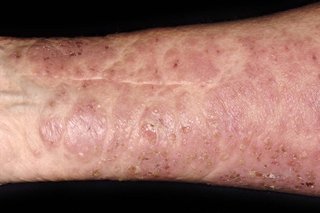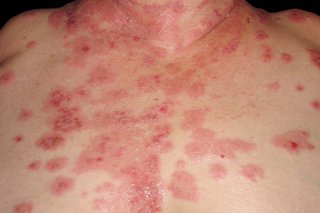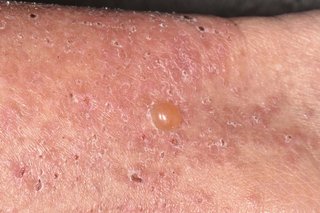Bullous pemphigoid
Symptoms of bullous pemphigoid
Bullous pemphigoid usually starts with an itchy, raised rash on the skin, usually the backs of the knees, insides of the armpits and elbows, hands, feet or tummy.

DR P. MARAZZI/SCIENCE PHOTO LIBRARY https://www.sciencephoto.com/media/711904/view

ISM/SCIENCE PHOTO LIBRARY https://www.sciencephoto.com/media/880176/view

DR P. MARAZZI/SCIENCE PHOTO LIBRARY https://www.sciencephoto.com/media/711900/view

DR P. MARAZZI/SCIENCE PHOTO LIBRARY https://www.sciencephoto.com/media/260961/view
Some people may also get blisters in their mouth, which can cause problems swallowing (dysphagia).
Not everyone gets blisters. If you do, they may keep coming and going for months or years.
Bullous pemphigoid eventually goes away on its own.
Non-urgent advice: See a GP if:
- you have an itchy rash that does not go away in a few weeks
- you have lots of blisters or big, painful blisters
- you have blisters that keep coming back
- you have blisters in your mouth and are finding it difficult to swallow
- your skin is painful, hot and swollen – the skin might also be red if it's an infection, but this may be less obvious on brown on black skin
- a blister is filled with pus or blood
Treatment for bullous pemphigoid
If a GP thinks you have bullous pemphigoid, they may refer you to a specialist for tests and treatment.
The main treatments for bullous pemphigoid are:
- steroid creams
- steroid tablets
- antibiotics
Treatment can help your skin heal, stop new patches or blisters appearing, and lower the chances of your skin getting infected.
Your skin should eventually heal without scarring, but it might be a bit darker than it was before.
Important
Do not burst your blisters yourself unless you have been shown how to by a nurse. Your skin might get infected.
Complications of bullous pemphigoid
Bullous pemphigoid can sometimes cause serious problems and may be life threatening to people at higher risk of complications.
The main risks are:
- skin infections, which can be very serious if they get deeper into your body (sepsis)
- side effects of steroid treatment, such as high blood pressure, weakened bones and a higher chance of getting infections
Steroids will be used as little as possible, and at the lowest possible dose, to help avoid side effects.
It's important to go to check-ups with your doctor so problems can be found and treated early.
Causes of bullous pemphigoid
Bullous pemphigoid is caused by a problem with the immune system, the body's defence against infection. Instead of attacking germs, it attacks and damages the skin.
It's not always clear why this happens, although certain things may trigger it.
These include:
- certain medicines
- sunburn
- surgery
- burns
Page last reviewed: 6 February 2025
Next review due: 6 February 2028